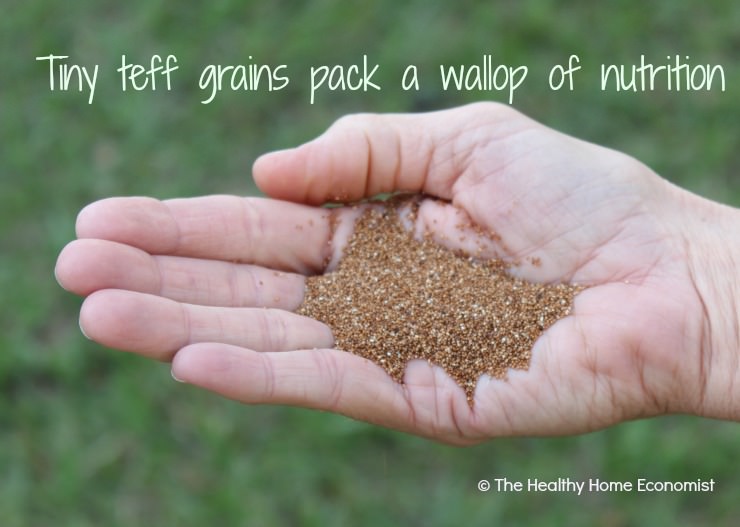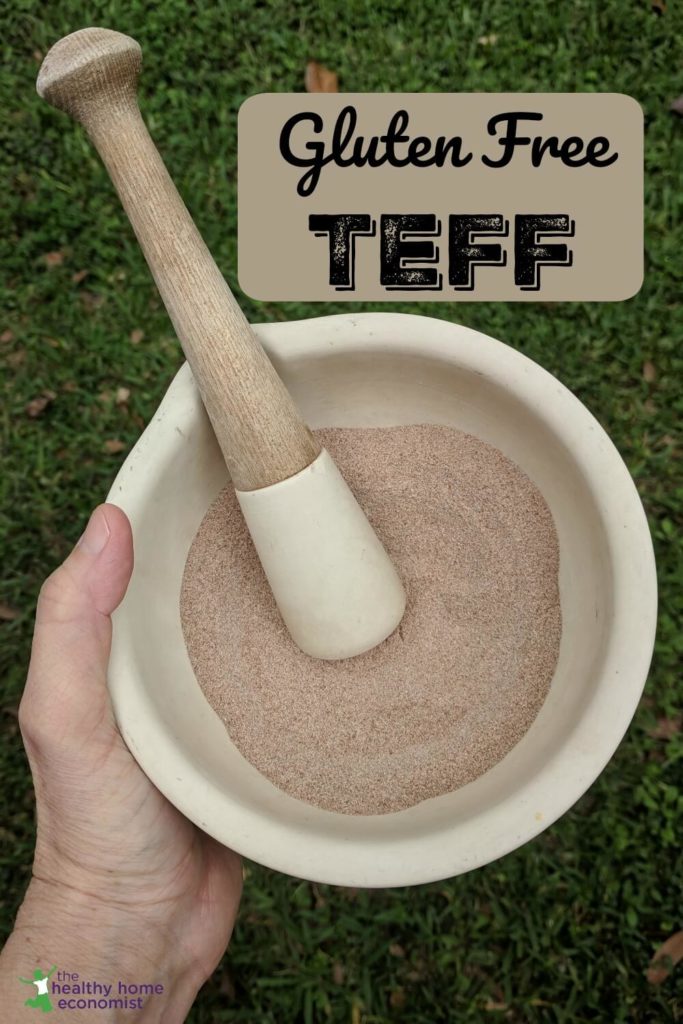 I first tasted the delicious, gluten free grain known as teff shortly after my husband and I were married. We met after work at an Ethiopian restaurant that we’d been wanting to try for quite some time. My husband was born and lived his early years in Uganda, and he was eager to introduce me to some of the flavors of his home continent.
I first tasted the delicious, gluten free grain known as teff shortly after my husband and I were married. We met after work at an Ethiopian restaurant that we’d been wanting to try for quite some time. My husband was born and lived his early years in Uganda, and he was eager to introduce me to some of the flavors of his home continent.
I was immediately enthralled and delighted by the basket of soft, spongy flatbread that was brought to our table to use as an edible utensil for our meat stew.
Never having experienced the light, slightly nutty flavor of teff before, I asked the waitress about the bread’s origins. She proudly explained that injera is a traditional fermented bread that is a staple in Ethiopia.
Traditional Teff Consumed for Thousands of Years
According to the Whole Grains Council, teff is thought to have made its debut in the human diet around 4000 B.C. in what is today the country of Ethiopia. Ethiopians obtain approximately two-thirds of their dietary protein from teff. The ultra tiny grain, smaller even than a chia seed, is what Ethiopia’s famously competitive long distance runners credit for their energy and stamina.
The tiny size of the teff grain, which can appear dark reddish brown to yellowish brown to ivory, made it the ideal food for the semi-nomadic life common throughout Ethiopian history. Only a handful of seed as shown in the picture above will sow an average size field no matter whether water-logged or dry! Thus, this practical grain is a dependable staple no matter what the environmental conditions.
In addition to climate, teff will grow at a variety of altitudes – from sea level to nearly 10,000 feet (300 meters). Its incredible versatility and hardiness has resulted in cultivation in diverse areas around the world. This includes mountainous Idaho, dry Australia, and low lying, wet areas of the Netherlands and India.
Is Teff Gluten Free?
Teff is one of the most nutritious of all gluten free grains.
Despite its tiny size, teff leads all other grains, gluten free or not, in calcium by a wide margin. This includes nutritious einkorn and millet.
It leads Paleo friendly foods used to substitute for grains like cassava and buckwheat as well.
Nutritional Information
Teff is high in many critical vitamins and minerals.
Magnesium, calcium, potassium, zinc, copper, and manganese round out the top six mineral nutrients.
Teff is extremely rich in B complex. It contains excellent amounts of choline, Vitamin B3 (niacin), Vitamin B6, Thiamin, Pantothenic Acid, and Riboflavin.
Teff Contains a Special Kind of Fiber
The biggest health benefit of teff may very well be its unique type of prebiotic starch.
Teff is high in resistant starch, a special type of dietary fiber only recently getting much attention from the research community. Resistant starch benefits blood sugar management, weight control, and overall health of the large intestine.
Up to 40% of the carbohydrates in teff are composed of gut strengthening resistant starches!
Milling Teff Grains
There is only downside to this amazing grain in my experience cooking and baking with it. Can you guess? It is so tiny that most grain mills can’t even grind it into flour!
Unless you have a special grain mill that can manage teff’s ultra miniscule size, it is best eaten in whole form as a delicious, mild, slightly nutty tasting porridge. Alternatively, you can add it to soups or stews to thicken and add texture.
 How to Sprout Teff Grains
How to Sprout Teff Grains
The tiny size of this gluten free grain requires only 36 hours or less to sprout – the shortest time of any grain. This is likely due to low amounts of mineral blocking phytic acid, although I was unable to find definite numbers on this to confirm.
If you would like to sprout your teff grains before cooking to add additional vitamins and render it even more digestible, follow these steps before cooking:
- Place 1 cup in a glass sprouting jar (I use these).
- Rinse the grains several times with filtered water until thoroughly wet. Drain completely.
- Lay the sprouting jar on its side to allow the circulation of air.
- Every few hours, rinse again and reset the jar on its side.
- Anywhere from a few hours to at most 36 hours (depending on the time of year and warmth/humidity in your home), the tiniest of buds will appear (they are very hard to see) and the sprouted teff grains will be ready for cooking (see toasting step below).
Teff Recipes
Toasted or soaked teff porridge is my personal favorite for a hot breakfast cereal. It beats out even that old stand-by overnight oatmeal. It is easy to make and a great place to start with teff in your kitchen.
This is especially true if you don’t currently have a specialized appliance that permits easy grinding of the tiny grains into fresh flour. I don’t recommend purchasing the flour for baking, as much of the nutritional benefit is lost within a few days of grinding.
If you enjoy the taste of teff after trying it, I recommend gluten free soaked amaranth porridge too. Amaranth is also slightly nutty in flavor and offers an excellent plant protein profile.
References
How to Mix and Use Gluten Free Flour
Boma: A Taste of Africa (Best Restaurant at Disney World)








Does it have a similar consistancy to Nan bread, ie like when eating Indian Curry or is it not as dense?
Sally,
I had the pleasure of working with two wonderful Ethiopian ladies for many years. They would have friendly competitions over who made the best injera, I was the lucky guinea pig. It is a very unusual texture and taste. Not dense like naan but more spongy, flexible, and light with a fermented almost sourdough taste. It is different but very easy to like!
Sarah, in a recent article you posted, it stated to never eat fruit with grains, because of the different manner in which the two are digested. Yet I notice here you said “serve with your favorite whole sweetener (I prefer raw honey) and/or fruits and nuts of choice” so I’m wondering, what is your current stand on using fruit with porridge. I really do miss having blueberries or raisins with my oatmeal. Thank you for this and other great articles.
That was another site or perhaps a guest post from someone with a different opinion … I’ve never written that! I eat fruit with grains all the time and always have. Nothing wrong with it at all. Our bodies can easily handle digesting different types of food at the same time unless perhaps we have digestive problems that need resolving.
I’m happy to hear it. I made Teff soaked porridge for breakfast, and am eager to add some fruit! Thank you.
Sarah,
Is teff allowed on the gaps diet?
No … it is a grain and all grains are excluded until the gut wall is healed and sealed. Then, grains can be reintroduced.
Popped teff is a fun snack too! Just put it in a dry skillet, heat, and it will pop just like corn!
Yum! Will have to try this!
Sarah, I love teff too and it seems even more satiating than oatmeal to me. After seeing this
——–>Teff is high in resistant starch, a newly-discovered type of dietary fiber that can benefit blood sugar management, weight control, and colon health. It’s estimated that 20-40% of the carbohydrates in teff are resistant starches. A gluten-free grain with a mild flavor, teff is a healthy and versatile ingredient for many gluten-free products.
(On the teff company website) I thought it must be the high amount of resistant starch that did that for me. But Tim, my go to source for all things Fiber at
http://vegetablepharm.blogspot.com
Just wrote in a comment that contrary to popular belief Teff has about the same amount of resistant starch as rice. And of course now that I look carefully at the above quote, I see it is an estimate of the amount of RS.
This does not mean that teff is any less good for us, just that we not not yet know precisely why. Maybe there are other fibers in it that combine with the RS.
Tim has also written a great deal about the difficulties in precisely quantifying RS at this point
I think there is much more research to be done on resistant starch, no doubt about that. The initial research is promising … I wouldn’t overanalyze it though and wonder if it is or isn’t less healthy than rice. Teff has been consumed for thousands of years and is so very digestible when prepared properly as traditionally done by the Ethiopians. Eat and enjoy 🙂 I actually find teff more digestible than rice but that is just one person’s observation.
I wonder if a coffee grinder would work?
Yes, supposedly it does. Coffee grinders are so tedious though, grinding only small amounts at a time. When I grind, I grind a couple gallon bags full of fresh flour and freeze to retain freshness (flour can be used straight out of the freezer).
My baby boys’ first “bread” was Injera. They were crazy about it!:) I suggest it as a wonderful first bread for babies, after they’ve had the standard egg yolk, avocado, and some other foods. I wonder what your thoughts are on that?
I didn’t introduce any grains until my children were over a year old. Teff would be a good first one to try though … especially injera which is fermented and would be very digestible.
I recently started eating buckwheat porridge in the mornings and it is also very similar to cream of wheat. It’s also low in phytic acid or just high in phytase. I am wondering if you know how similar the nutrition content is to teff, and how they compare, especially in minerals and resistant starch. Thanks for another great breakfast idea!!
We are HUGE fan’s of Teff. Our daughter has a lot of digestive issues and reactions to many foods but her body loves Teff.
We buy our grain and flour from the Teff Company. Excellent product. We use both the ivory or brown depending on the dish.
Is their Teff organic? I checked the website but didn’t find anything about it being organic. I know that sometimes farmers don’t seek organic certification due to expense are but not spraying their crops with pesticides. Do you know what the Teff Company’s practices are?
Do you have a recipe for that yummy sounding bread that you talked about in your article? I would love to try that.
Me too! Was just going to post that exact thing!
Hi Dorsey,
The book Flatbreads and Flavors has a receipe for injera.